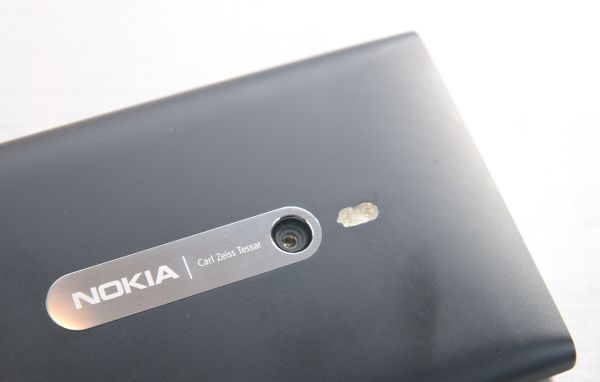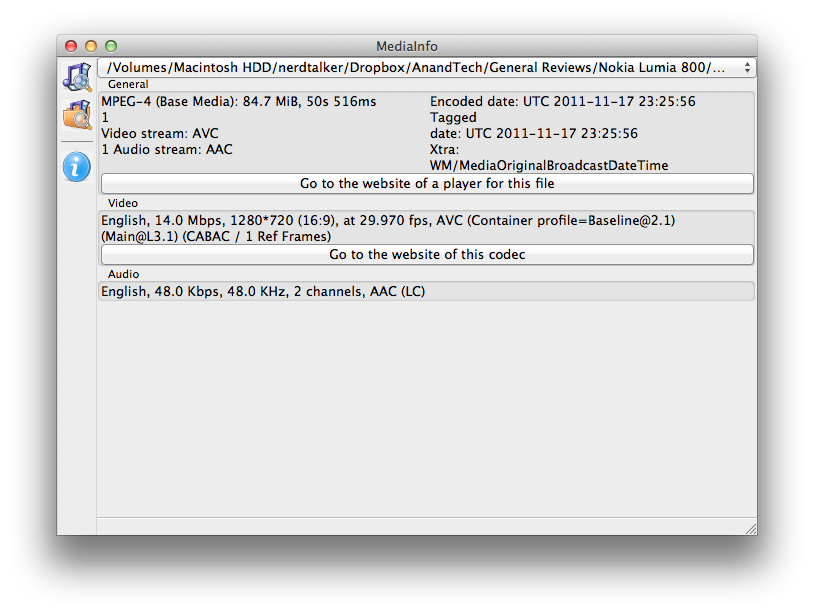Nokia Lumia 800 Review - Nokia's Brave New Foray into WP7
by Brian Klug on January 4, 2012 7:00 AM EST- Posted in
- Smartphones
- Nokia
- windows phone 7
- Mobile
- WP7
- Lumia
- Lumia 800
One of the big things people were alluding to when they talked about how much they wanted Nokia to make a Windows Phone was the camera. Though the other smartphone OEMs are fast catching up, Nokia still has something of a unique position in the smartphone camera world thanks to its positioning with Zeiss and long history of making devices literally built around their camera. In addition, WP7 puts some emphasis on the importance of the camera with their mandatory two-step camera button, and unfortunately until this generation many of the WP7 devices haven’t really shipped high-end cameras. I wager that many wanted the N8 camera in a Windows Phone, and though the Lumia 800 (and N9) don’t have that kind of design around the camera module, they don’t skimp either.
Before we go too further, let’s cover the logistics. The Lumia 800, like all Windows Phones, has a dedicated two-step camera button. It feels nice and clicky, and the two detents are easy enough to find and use. Nokia also locates its camera in the center of the device, which is unique and awesome for positioning the device with a tripod or mount - not a big thing for most users but still an intriguing choice. Since each Windows Phone can have different camera UI options it also bears going over those, and the Lumia 800 has more than most I’ve seen in a while. Shooting scenes, white balance, exposure offset, ISO, metering mode, contrast, saturation, focus (Macro or Normal), and resolution are all listed in still mode. Macro mode might sound a big confusing - this mode actually just gives you the full focus range (but as a result takes longer to run the AF routine) whereas normal has a more clamped range. WP7.5 also now saves and makes camera settings persistent after a close, something that was previously a big annoyance.
On paper the Lumia 800’s camera is definitely latest and greatest. It combines an 8 MP CMOS sensor that shoots stills of size 3264x2448 (4:3) or 3552x1998 (16:9) which is something we haven’t really seen before. Usually selecting a 16:9 shooting mode simply crops pixels off the top and bottom - on the Lumia 800, selecting this 16:9 mode does shave off some at the top and bottom, but gives you 288 more pixels in the horizontal direction and a truly wider field of view.

The only way I can see this being possible is that their CMOS really has an effective area of 3552x2448 (or slightly higher) and thus, both modes are a crop of that area. If you superimpose images from the two modes you can see that this is indeed the case (magnification remains the same). Nokia makes a big deal about this (as they well should) because it’s a pretty cool feature. As far as I can tell, the 8MP CMOS sensor’s size is 1/3.0” just like the N9. After a fair amount of digging, I tracked down that the CMOS sensor is “CMCS-85T330,” however this is an unfamiliar name to me. Based on the size and width, the pixels are no doubt in the 1.4µm class, however.
The Lumia 800 uses a Carl Zeiss branded optical system with an F/# of 2.2, which puts it in a small list of smartphones with F/2.2 optics. The camera module in the Lumia 800 is actually the same as the one inside the Nokia N9, and as a result performance differences between the two highlight the big differences in ISP between OMAP3 and MSM8x55. It’s difficult to know more about the intricacies of Nokia’s camera design, so I reached out on Twitter and learned that this design is indeed 5P (denoting 5 plastic elements) as opposed to the 4P that we’ve seen in many previous designs.
@nerdtalker lumia 800 is using a 5 element lens design.
— Damian Dinning (@PhoneDaz) November 8, 2011
On paper, the Lumia 800’s camera system is absolutely top tier, now the question becomes how it performs in our controlled and outdoor testing. To evaluate this, we turned to our lightbox tests with the lights on and off, outdoor testing at our test locations, and the new semi-revamped camera tests with the ISO12233, distortion, and color checker charts.
In the lightbox test with the lights on, the Lumia 800 is unsurprisingly very sharp. The small focus grooves on the Exakta are easy to make out and show very well. I think JPEG compression in WP7 or ISP might have been a bit aggressive here as the file is only 1.1 MB and shows some compression artifacts around lettering on the camera and other high spatial frequencies. The compression artifacts actually have the unintended consequence of somewhat masking sensor noise in the lights on test as well. The other complaint is that the image is very undersaturated and lifeless, unfortunately. I feel like this is some AWB issue since numerous other photos with the Lumia 800 not in a controlled box have great white balance. With the lights off (and using the dual LED flash) the Lumia 800 actually looks way more saturated and lively. WP7 also deserves lots of credit for always illuminating a dark scene during the autofocus routine, something so many smartphones still aren’t doing right.
The other controlled tests sort of tell the same story. The GMB color checker card looks a bit red, and a few other shots were blue of the same target. I don’t exactly have daylight color temperature bulbs or anything scientific for testing (yet) but this hunting around for proper white balance seems to be something specific to QCT’s SoCs still. Distortion is pretty low, again compared to SGS2 and some other culprits not a big deal at all. The ISO12233 charts also show that the Lumia’s camera (and by relation ISP and Windows Phone) don’t do absurd oversharpening like we’ve seen on some phones. We also see spatial frequencies on par with the other 8 MP shooters, though not much more. I can see up to the 14 line in the horizontal direction and 15 in the vertical before the contrast reversal. It’s clear to me at least that smartphone optical designs are obviously not diffraction-limited for obvious reasons.
It is in the outdoor scenes, the Lumia 800 really shines and starts to look a lot like the Nokia cameras of note we’ve seen before. Again we don’t have access to locations 1 or 2 anymore, only 3, 4, 5, 6, and 7 are refreshed. In addition, seasons changing makes getting the same lighting difficult. In virtually every scene the Lumia 800 has excellent sharpness and appearance. Only in test 7 is the Lumia 800 strangely bluer than most.
Unsurprisingly, the Lumia 800’s camera comes out looking very good against the rest of the 8MP competition, and for me this is the first F/2.2 8 MP shooter I’ve come across. With less compression and better ISP, it could be even better than most. Although I haven’t had a chance to test the N9, it would be interesting to see the differences that its very different ISP makes for.
Video
The Lumia 800 shoots HD video at up to 720p30 at 14.0 Mbps H.264 baseline. This is a pretty high bitrate for 720p and, despite being baseline CABAC with 1 reference frame, looks very good. It is a bit strange to see a super high end level smartphone shipping which only records up to 720p, but I’d personally take really good 720p over mediocre 1080p any day (just another place where looking only at video resolution can be misleading). This 720p limitation is no doubt a result of limitations imposed by MSM8255’s onboard video encoder, which to my knowledge can only encode up to 1280x720 H.264. The Windows Phone team likes to talk about how they don’t need the bleeding edge of SoC performance, but this is just another axis of improvement that isn’t strictly pure performance. Audio shot with the video is stereo AAC at 48.0 Kbps 48 kHz.
Oddly enough the Lumia 800 software defaults to shooting VGA unless you go in and select 720p instead. Controls here remain notably verbose, including most of the same ISO, exposure, and shooting mode options, in addition to continuous AF options.
As usual, we shot video using the phone under test at the our bench location and uploaded the result to YouTube and locally (89 MB) so you can watch without the YouTube transcode.
Given this bitrate and optics quality it’s unsurprising to me that the Lumia 800’s 720p30 quality is awesome. The video is sharp and subjectively looks awesome. In addition, its continuous autofocus runs quickly and without too much distraction. The Lumia 800 ends up falling into that category we talked about earlier of devices that don’t ship with 1080p video recording capabilities but instead deliver excellent 720p at a similar bitrate.
















































120 Comments
View All Comments
Starfireaw11 - Wednesday, January 4, 2012 - link
For the most part, my Lumia 800 is fast, responsive and smooth. There are a few times where you do notice a bit of a slowdown, but certainly nothing worse than any other phone I've ever come across.A smartphone will always be a balancing act between power consumption, cost and performance, while maintaining a small form-factor. While a Xeon based smartphone would be possible, I don't see one being commercially successful for some reason :D
bplewis24 - Wednesday, January 4, 2012 - link
Android doesn't have bloated applications nor a bloated OS. Troll harder, or become informed as to what you actually speak of.N4g4rok - Wednesday, January 4, 2012 - link
My apologies, i should have specified.Over time, Android will slow down from fragmentation issues, like most OS's, but i've read more complaints recently about older versions of Android.
And unfortunately, due to poor coding, applications will occasionally succumb to memory leaks, further bogging down the OS. Of course killing the application will fix the problem.
It does not make Android inherently bad. It just makes the point that the OS would likely struggle on lower powered single core SoC's that some other phones have.
Penti - Wednesday, January 4, 2012 - link
Making core applications and libraries thread on a dual-core or quad-core SoC is just one way of speeding up some of the slower bits. But that's just a stop gap and just one way of doing it. You could just as easily do improvements for single-core SoC's there as well. Fragmentation actually helps overcome some of this. As the vendors put in improvements and eventually gets Google to redesign or implement new things. Just as you would get an actual NDK for WP at some point and can actually write and port normal applications to that platform. Which isn't trouble free. Which will hit limitations and which will fragment ones phone makers invest some into that platform. Nokia and ST-E will bring in none-Qualcomm hardware. They will bring in core alterations to the software and platform and eventually as it has already proven it will be hard to maintain everything.Just remember WP7 didn't even get sockets until Mango. Stuff like Spotify was ready for MeeGo at pretty much when Nokia released a device and released before Mango got it's client. Just because it got another model to paint stuff on the screen doesn't mean it is superior. Of course poor launchers can destroy a phone, but that is not where it's heading at with many of the vendors having already improved on that. Just look in another year and you will see a whole different market with dual-core being the standard platform driving WP. It took a year to even get basic applications on there... The development kit hasn't been proven as good as advertised by astroturfers. Nobody will make a business on a platform where you can sit and wait a year for even features 10 year old feature phones had.
N4g4rok - Wednesday, January 4, 2012 - link
I agree with that, and i do not mean to insist that WP7 is or will be superior to anything else.The options and large market share that Android offers makes it extremely attractive to multiple vendors, and on top of that, it's flexibility as a development platform is the icing on the cake. Combine that with Google's monitoring of software compatibilities and updating to suit, you end up with a solid, stable platform, just like their most recent releases are shaping up to be.
WP7 has neither of those qualities just yet. Although Microsoft may move in that direction with future releases,but they're taking their time to do it. Taking the time to ensure hardware compatibility is great, but like you mentioned, taking too long getting it up to speed will achieve nothing other than wasting a lot of time and money.
crispbp04 - Wednesday, January 4, 2012 - link
Look at the pot calling the kettle black.doubledeej - Thursday, January 5, 2012 - link
I've had two different top-of-the-line Android phones and they were both horribly slow and liked to stutter constantly. It was very annoying. I switched to WP7 and haven't looked back.steven75 - Wednesday, January 4, 2012 - link
"I've had the device for about a month now and I have to agree with everything that has been said in this article - I'm really happy with it and it's a huge improvement over the iOS,"Except the review doesn't say this. It basically points out that WP7 Mango is where iOS and Android were a year ago.
crispbp04 - Wednesday, January 4, 2012 - link
Weak editorial. I lol'd at "fledgling application ecosystem".Spivonious - Wednesday, January 4, 2012 - link
Yeah, aren't there like 200,000 apps now? All of the needed ones are there.I've been very impressed with WP7 Mango. The fact is that you don't need apps because lots of functionality is built in. People hub gets you Facebook, Twitter, LinkedIn, as well as standard contact info and links to send texts, IMs, emails, post on walls, etc. The Messaging hub combines texting, IM, and emails, grouped by the person you're conversing with. The Xbox hub places all of your games in one place. The Music+Video hub places all of your media and media-watching apps in one place. Bing Search combines web search, Sound Hound, Google Goggles, and Yelp.
And live tiles on the main screen let me see what I'm looking for without opening an app.
The strength of WP7 is the integration of services in one place. It's perfect for the average consumer.